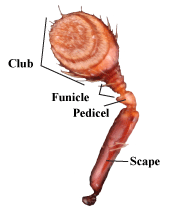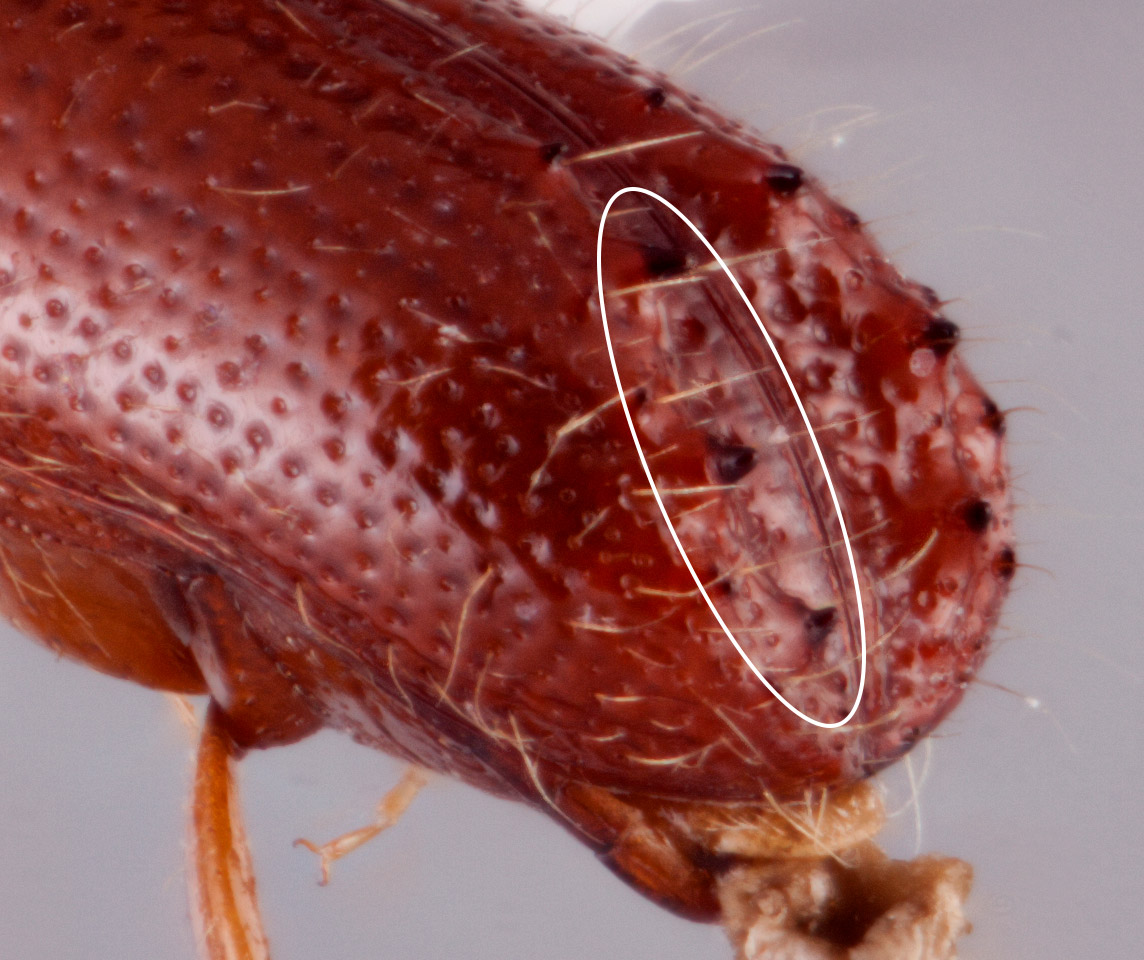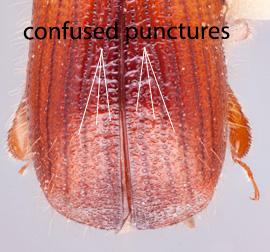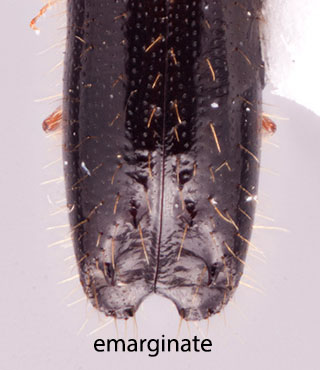About this tool
Is it a xyleborine ambrosia beetle?
What makes a scolytine?
Scolytine ambrosia beetles are actually snoutless weevils (Curculionidae) (Jordal et al. 2014Jordal et al. 2014:
Jordal BH, Smith SM, Cognato AI. 2014. Classification of weevils as a data-
driven science: leaving opinion behind. ZooKeys 439: 1minus;18.
https://doi.org/10.3897/zookeys.439.8391)! Members of this subfamily are characterized by having the rostrum (snout) absent or reduced, eyes that are never round, elbowed antennaeantenna:
paired segmental sensory appendages borne on each side of the head; comprised of (from proximal to distal) the scape, pedicel, funicle and club with a clubclub:
with a clubclub:
the broadened, flattened end of antenna, in Xyleborini comprised of three segments , and a protibiaprotibia:
, and a protibiaprotibia:
tibia of the first pair of legs
which is armed by more structures (ex. denticlesdenticle:
a small tooth, the sides of which are equal and the tip is above the middle of the base , tuberclestubercle:
, tuberclestubercle:
a small knob-like or rounded protuberance of the exoskeleton , rugae, etc.) than a single apicalapex:
, rugae, etc.) than a single apicalapex:
point or edge furthest from the body; opposite of base
 spine. They are small in size, 0.7–12.0 mm in length, with most species around 3.0 mm long, body narrowly elongate to broadly ovate.
spine. They are small in size, 0.7–12.0 mm in length, with most species around 3.0 mm long, body narrowly elongate to broadly ovate.
The group Scolytinae contains 6,300 species. But they are diverse not only in terms of species, but also in their ecology, morphology, and genetics. Scolytines are found in all regions of the world but are most abundant and diverse in the tropics. They reproduce within plant tissues, and different species specialize on different plant parts: from bark to xylem and from roots to fruit; a few species even reproduce in forbs and grasses. Most species, however, feed either on phloem in dead trees (those are called bark beetles) or on symbiotic fungi (ambrosia beetles). Bark beetles feed almost exclusively on phloem and cambium of declining or dead trees. They create tunnels termed ‘galleries’ in the phloem along which they lay eggs. Larvae hatch and typically create their own galleries radiating away from that constructed by the parents. These galleries are visible when bark is removed and may be diagnostic for species (Hulcr et al. 2015Hulcr et al. 2015:
Hulcr J, Atkinson TH, Cognato AI, Jordal BH, McKenna DD. 2015. Morphology, taxonomy, and phylogenetics of bark beetles. In: Vega FE, Hofstetter RW (Eds) Bark beetles: biology and ecology of native and invasive species. Elsevier, San Diego, CA, 41minus;84.).
The ambrosia beetles tunnel directly into the sapwood of their host where they cultivate a symbiotic fungus. The fungus is transported in specialized structures termed ‘ mycangiamycangia:
structures used to carry fungal symbionts; highly morphologically variable
 ’. The beetles and their larvae either consume only the fungus or a combination of wood and fungus. Ambrosia beetle galleries are harder to see without dissecting the wood. The largest group of ambrosia beetles is the tribe Xyleborini. Xyleborini contain over 1,300 species, including many important pests and globally widespread and abundant invasive beetles, and as such are some of the most encountered scolytine groups. Xyleborini is the focal group of this identification tool.
’. The beetles and their larvae either consume only the fungus or a combination of wood and fungus. Ambrosia beetle galleries are harder to see without dissecting the wood. The largest group of ambrosia beetles is the tribe Xyleborini. Xyleborini contain over 1,300 species, including many important pests and globally widespread and abundant invasive beetles, and as such are some of the most encountered scolytine groups. Xyleborini is the focal group of this identification tool.
How to identify scolytines from other beetles that may be confused with them?
Several other beetle groups can be easily confusedconfused:
of markings, having indefinite outlines or running together as lines or spots without definite pattern; usually referring to punctures with scolytines, including cossonine weevils (another weevil subfamily), bostrichids (Bostrichidae, powder post beetles), ciids (Ciidae, minute tree-fungus beetles), and anobiids (Ptinidae: Anobiinae, death watch beetles). These groups of beetles have similar feeding habits, body size, or are often caught in scolytine traps. Superficially, they have similar body shapes as scolytines, but round eyes distinguish them. Bostrichids and anobiids can be further distinguished by the antennaeantenna:
with scolytines, including cossonine weevils (another weevil subfamily), bostrichids (Bostrichidae, powder post beetles), ciids (Ciidae, minute tree-fungus beetles), and anobiids (Ptinidae: Anobiinae, death watch beetles). These groups of beetles have similar feeding habits, body size, or are often caught in scolytine traps. Superficially, they have similar body shapes as scolytines, but round eyes distinguish them. Bostrichids and anobiids can be further distinguished by the antennaeantenna:
paired segmental sensory appendages borne on each side of the head; comprised of (from proximal to distal) the scape, pedicel, funicle and club which are neither elbowed nor clubbed, and from cossonines by the presence of a large apicalapex:
which are neither elbowed nor clubbed, and from cossonines by the presence of a large apicalapex:
point or edge furthest from the body; opposite of base
 spine on the protibiaprotibia:
spine on the protibiaprotibia:
tibia of the first pair of legs
. One scolytine tribe, Scolytini, also possesses a protibiaprotibia:
tibia of the first pair of legs
with only an apicalapex:
point or edge furthest from the body; opposite of base
 spine, but the eyes are never round. Phloeotribini bark beetles possess a lamellate antennalantennal:
spine, but the eyes are never round. Phloeotribini bark beetles possess a lamellate antennalantennal:
pertaining to the antennae
club similar to Bostrichidae, but again, the eye is emarginateemarginate:
notched at the margin .
.
Is it a xyleborine ambrosia beetle?
Xyleborine ambrosia beetles can be distinguished from all other scolytines by the combination of the following characters: eyes emarginateemarginate:
notched at the margin , tibiae flat and broad with convexconvex:
, tibiae flat and broad with convexconvex:
appearing rounded outer edge and possessing at least six denticlesdenticle:
outer edge and possessing at least six denticlesdenticle:
a small tooth, the sides of which are equal and the tip is above the middle of the base (very few exceptions with as few as four denticlesdenticle:
(very few exceptions with as few as four denticlesdenticle:
a small tooth, the sides of which are equal and the tip is above the middle of the base ), pronotumpronotum:
), pronotumpronotum:
the dorsal surface of the thorax
strongly convexconvex:
appearing rounded and armed with asperitiesasperity:
and armed with asperitiesasperity:
small flat denticle-like structures frequently arranged in rows or confined to specific areas
 on the anterioranterior:
on the anterioranterior:
the front or forward; opposite of posterior slope, antennalantennal:
slope, antennalantennal:
pertaining to the antennae
club dorsoventrally flattened, and depressed submentum. Equally important are biological characters: all Xyleborini are haplodiploid inbreeders (each family has usually only one male, dwarfed, flightless, and haploid) and obligate fungus farmers. Their dependence on fungi means that almost all species have a mycangium, but that may or may not be externally visible.
What tools are necessary to identify xyleborine specimens?
Due to the small size of many xyleborines, a high-powered dissecting scope and a good light source are necessary for identification. We strongly recommend that specimens are examined dry, as many of the diagnostic characteristics are obscured or not visible while the specimen is in ethanol; this is exceptionally true for Cyclorhipidion, Microperus, and Xyleborinus species. The specimen can then be returned to alcohol once the identification has been made. In some cases, access to a DNA sequencing facility will be necessary, especially to identify males and larvae.
What if the specimen doesn’t match any of the included species?
This tool allows for the identification of all species from mainland Southeast Asia, Taiwan, Korea, and Japan reported prior to 2020 with a few exceptions. If a specimen does not match any of the included species, it is quite possible that it is either represents new record for the region, or it is a species new to science. Should this scenario arise, please contact one of the content authors.

